Leadership and Management Development Strategies for Organizations
VerifiedAdded on 2020/07/22
|18
|5541
|30
Report
AI Summary
This report delves into the crucial aspects of leadership and management within an organizational context. It begins by highlighting the significance of both leadership and management in driving organizational success, emphasizing the importance of a leader's ability to influence and motivate, as well as the role of management in organizing and utilizing resources effectively. The report then examines the key differences between leadership and management, exploring various leadership theories such as the Great Man Theory, Trait Theory, Behavioral Theory, and Situational Theory, along with their respective strengths and limitations. It also discusses different leadership styles, including autocratic, participative, and laissez-faire styles, and provides insights into transactional and transformational leadership approaches. The report further elaborates on leadership development strategies, emphasizing the importance of adapting leadership styles to different situations and organizational needs. The analysis includes a case study of an associate director in a non-profit agency, illustrating practical applications of leadership and management principles in real-world scenarios. Finally, the report concludes with a comprehensive overview of the discussed concepts and their implications for organizational effectiveness.
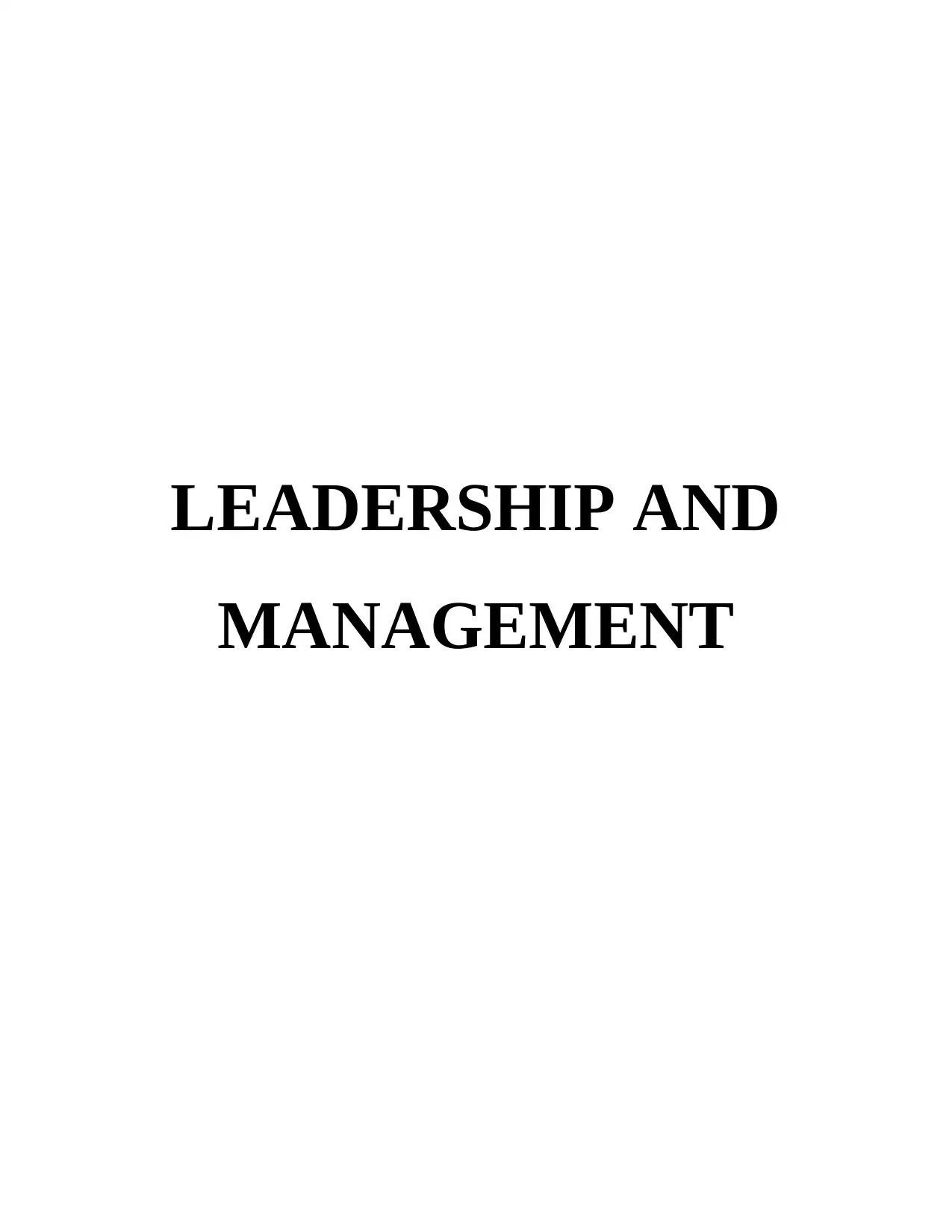
LEADERSHIP AND
MANAGEMENT
MANAGEMENT
Paraphrase This Document
Need a fresh take? Get an instant paraphrase of this document with our AI Paraphraser
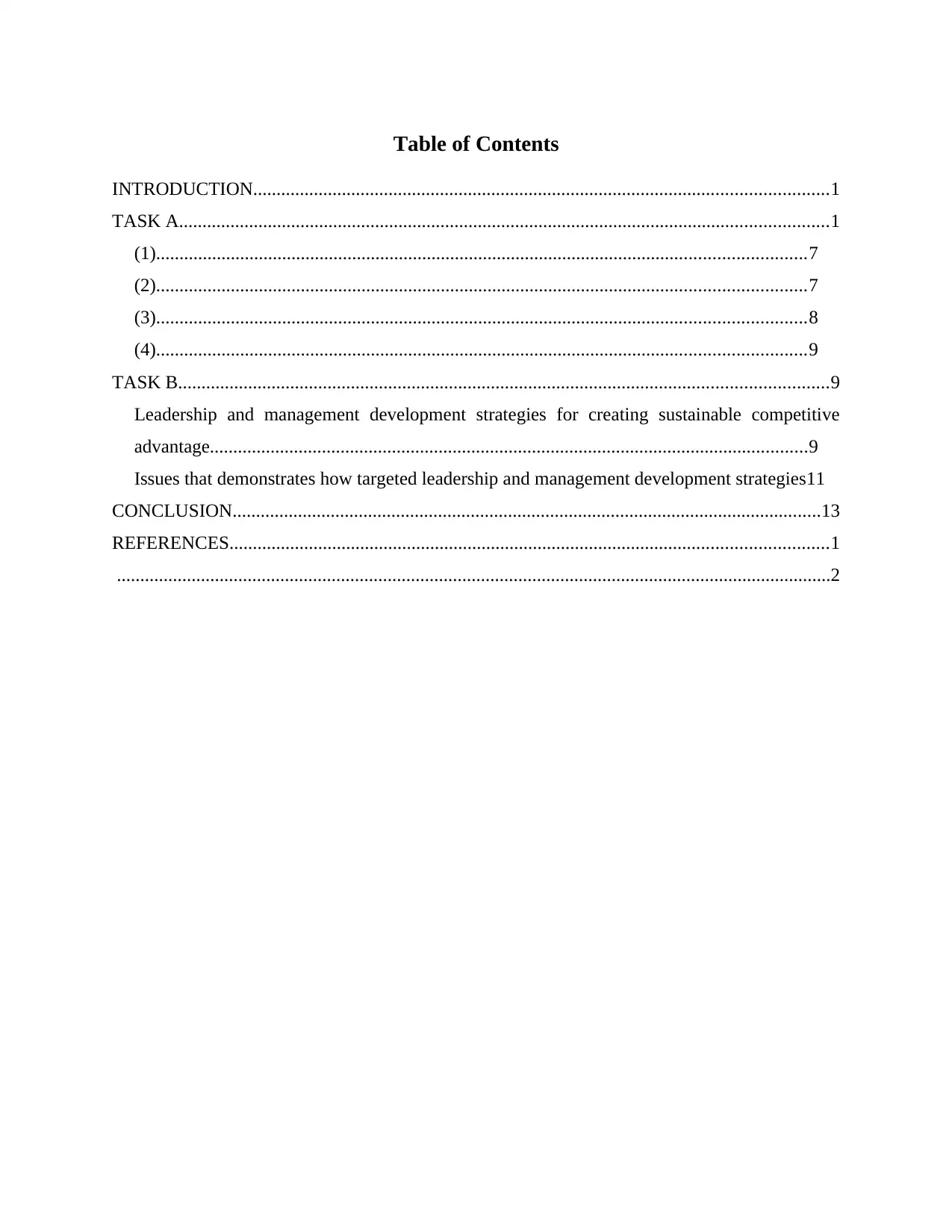
Table of Contents
INTRODUCTION...........................................................................................................................1
TASK A...........................................................................................................................................1
(1)...........................................................................................................................................7
(2)...........................................................................................................................................7
(3)...........................................................................................................................................8
(4)...........................................................................................................................................9
TASK B...........................................................................................................................................9
Leadership and management development strategies for creating sustainable competitive
advantage................................................................................................................................9
Issues that demonstrates how targeted leadership and management development strategies11
CONCLUSION..............................................................................................................................13
REFERENCES................................................................................................................................1
.........................................................................................................................................................2
INTRODUCTION...........................................................................................................................1
TASK A...........................................................................................................................................1
(1)...........................................................................................................................................7
(2)...........................................................................................................................................7
(3)...........................................................................................................................................8
(4)...........................................................................................................................................9
TASK B...........................................................................................................................................9
Leadership and management development strategies for creating sustainable competitive
advantage................................................................................................................................9
Issues that demonstrates how targeted leadership and management development strategies11
CONCLUSION..............................................................................................................................13
REFERENCES................................................................................................................................1
.........................................................................................................................................................2

⊘ This is a preview!⊘
Do you want full access?
Subscribe today to unlock all pages.

Trusted by 1+ million students worldwide
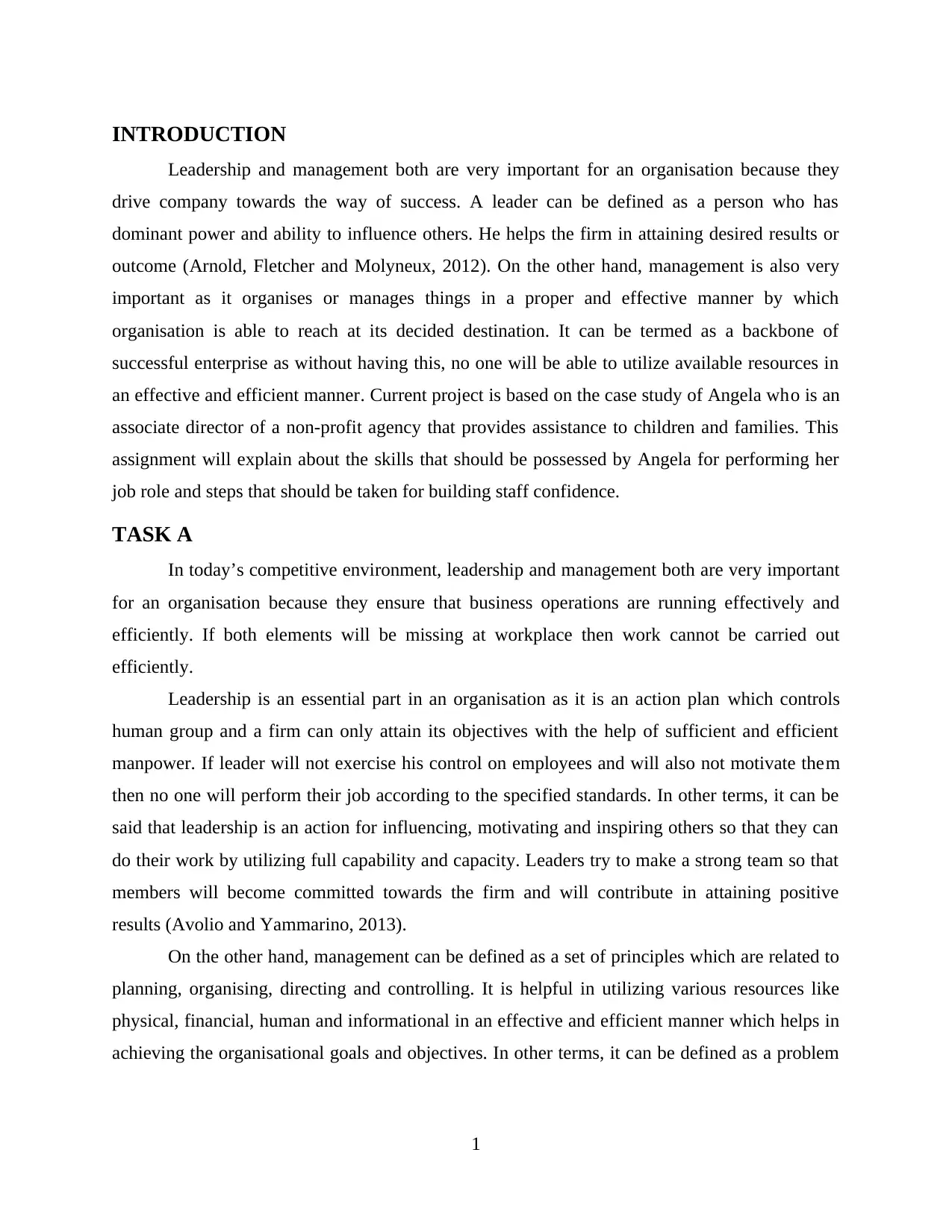
INTRODUCTION
Leadership and management both are very important for an organisation because they
drive company towards the way of success. A leader can be defined as a person who has
dominant power and ability to influence others. He helps the firm in attaining desired results or
outcome (Arnold, Fletcher and Molyneux, 2012). On the other hand, management is also very
important as it organises or manages things in a proper and effective manner by which
organisation is able to reach at its decided destination. It can be termed as a backbone of
successful enterprise as without having this, no one will be able to utilize available resources in
an effective and efficient manner. Current project is based on the case study of Angela who is an
associate director of a non-profit agency that provides assistance to children and families. This
assignment will explain about the skills that should be possessed by Angela for performing her
job role and steps that should be taken for building staff confidence.
TASK A
In today’s competitive environment, leadership and management both are very important
for an organisation because they ensure that business operations are running effectively and
efficiently. If both elements will be missing at workplace then work cannot be carried out
efficiently.
Leadership is an essential part in an organisation as it is an action plan which controls
human group and a firm can only attain its objectives with the help of sufficient and efficient
manpower. If leader will not exercise his control on employees and will also not motivate them
then no one will perform their job according to the specified standards. In other terms, it can be
said that leadership is an action for influencing, motivating and inspiring others so that they can
do their work by utilizing full capability and capacity. Leaders try to make a strong team so that
members will become committed towards the firm and will contribute in attaining positive
results (Avolio and Yammarino, 2013).
On the other hand, management can be defined as a set of principles which are related to
planning, organising, directing and controlling. It is helpful in utilizing various resources like
physical, financial, human and informational in an effective and efficient manner which helps in
achieving the organisational goals and objectives. In other terms, it can be defined as a problem
1
Leadership and management both are very important for an organisation because they
drive company towards the way of success. A leader can be defined as a person who has
dominant power and ability to influence others. He helps the firm in attaining desired results or
outcome (Arnold, Fletcher and Molyneux, 2012). On the other hand, management is also very
important as it organises or manages things in a proper and effective manner by which
organisation is able to reach at its decided destination. It can be termed as a backbone of
successful enterprise as without having this, no one will be able to utilize available resources in
an effective and efficient manner. Current project is based on the case study of Angela who is an
associate director of a non-profit agency that provides assistance to children and families. This
assignment will explain about the skills that should be possessed by Angela for performing her
job role and steps that should be taken for building staff confidence.
TASK A
In today’s competitive environment, leadership and management both are very important
for an organisation because they ensure that business operations are running effectively and
efficiently. If both elements will be missing at workplace then work cannot be carried out
efficiently.
Leadership is an essential part in an organisation as it is an action plan which controls
human group and a firm can only attain its objectives with the help of sufficient and efficient
manpower. If leader will not exercise his control on employees and will also not motivate them
then no one will perform their job according to the specified standards. In other terms, it can be
said that leadership is an action for influencing, motivating and inspiring others so that they can
do their work by utilizing full capability and capacity. Leaders try to make a strong team so that
members will become committed towards the firm and will contribute in attaining positive
results (Avolio and Yammarino, 2013).
On the other hand, management can be defined as a set of principles which are related to
planning, organising, directing and controlling. It is helpful in utilizing various resources like
physical, financial, human and informational in an effective and efficient manner which helps in
achieving the organisational goals and objectives. In other terms, it can be defined as a problem
1
Paraphrase This Document
Need a fresh take? Get an instant paraphrase of this document with our AI Paraphraser
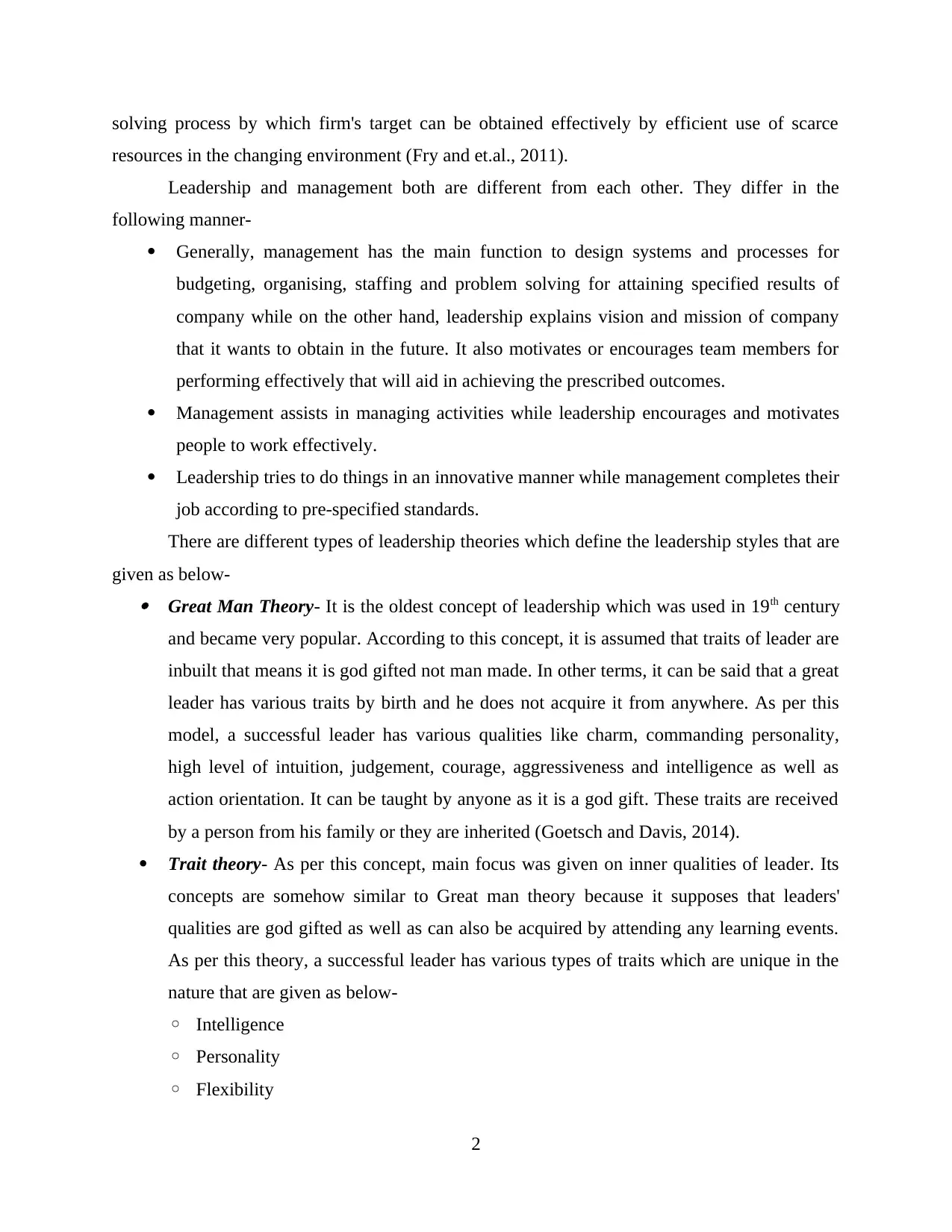
solving process by which firm's target can be obtained effectively by efficient use of scarce
resources in the changing environment (Fry and et.al., 2011).
Leadership and management both are different from each other. They differ in the
following manner-
Generally, management has the main function to design systems and processes for
budgeting, organising, staffing and problem solving for attaining specified results of
company while on the other hand, leadership explains vision and mission of company
that it wants to obtain in the future. It also motivates or encourages team members for
performing effectively that will aid in achieving the prescribed outcomes.
Management assists in managing activities while leadership encourages and motivates
people to work effectively.
Leadership tries to do things in an innovative manner while management completes their
job according to pre-specified standards.
There are different types of leadership theories which define the leadership styles that are
given as below- Great Man Theory- It is the oldest concept of leadership which was used in 19th century
and became very popular. According to this concept, it is assumed that traits of leader are
inbuilt that means it is god gifted not man made. In other terms, it can be said that a great
leader has various traits by birth and he does not acquire it from anywhere. As per this
model, a successful leader has various qualities like charm, commanding personality,
high level of intuition, judgement, courage, aggressiveness and intelligence as well as
action orientation. It can be taught by anyone as it is a god gift. These traits are received
by a person from his family or they are inherited (Goetsch and Davis, 2014).
Trait theory- As per this concept, main focus was given on inner qualities of leader. Its
concepts are somehow similar to Great man theory because it supposes that leaders'
qualities are god gifted as well as can also be acquired by attending any learning events.
As per this theory, a successful leader has various types of traits which are unique in the
nature that are given as below-
◦ Intelligence
◦ Personality
◦ Flexibility
2
resources in the changing environment (Fry and et.al., 2011).
Leadership and management both are different from each other. They differ in the
following manner-
Generally, management has the main function to design systems and processes for
budgeting, organising, staffing and problem solving for attaining specified results of
company while on the other hand, leadership explains vision and mission of company
that it wants to obtain in the future. It also motivates or encourages team members for
performing effectively that will aid in achieving the prescribed outcomes.
Management assists in managing activities while leadership encourages and motivates
people to work effectively.
Leadership tries to do things in an innovative manner while management completes their
job according to pre-specified standards.
There are different types of leadership theories which define the leadership styles that are
given as below- Great Man Theory- It is the oldest concept of leadership which was used in 19th century
and became very popular. According to this concept, it is assumed that traits of leader are
inbuilt that means it is god gifted not man made. In other terms, it can be said that a great
leader has various traits by birth and he does not acquire it from anywhere. As per this
model, a successful leader has various qualities like charm, commanding personality,
high level of intuition, judgement, courage, aggressiveness and intelligence as well as
action orientation. It can be taught by anyone as it is a god gift. These traits are received
by a person from his family or they are inherited (Goetsch and Davis, 2014).
Trait theory- As per this concept, main focus was given on inner qualities of leader. Its
concepts are somehow similar to Great man theory because it supposes that leaders'
qualities are god gifted as well as can also be acquired by attending any learning events.
As per this theory, a successful leader has various types of traits which are unique in the
nature that are given as below-
◦ Intelligence
◦ Personality
◦ Flexibility
2
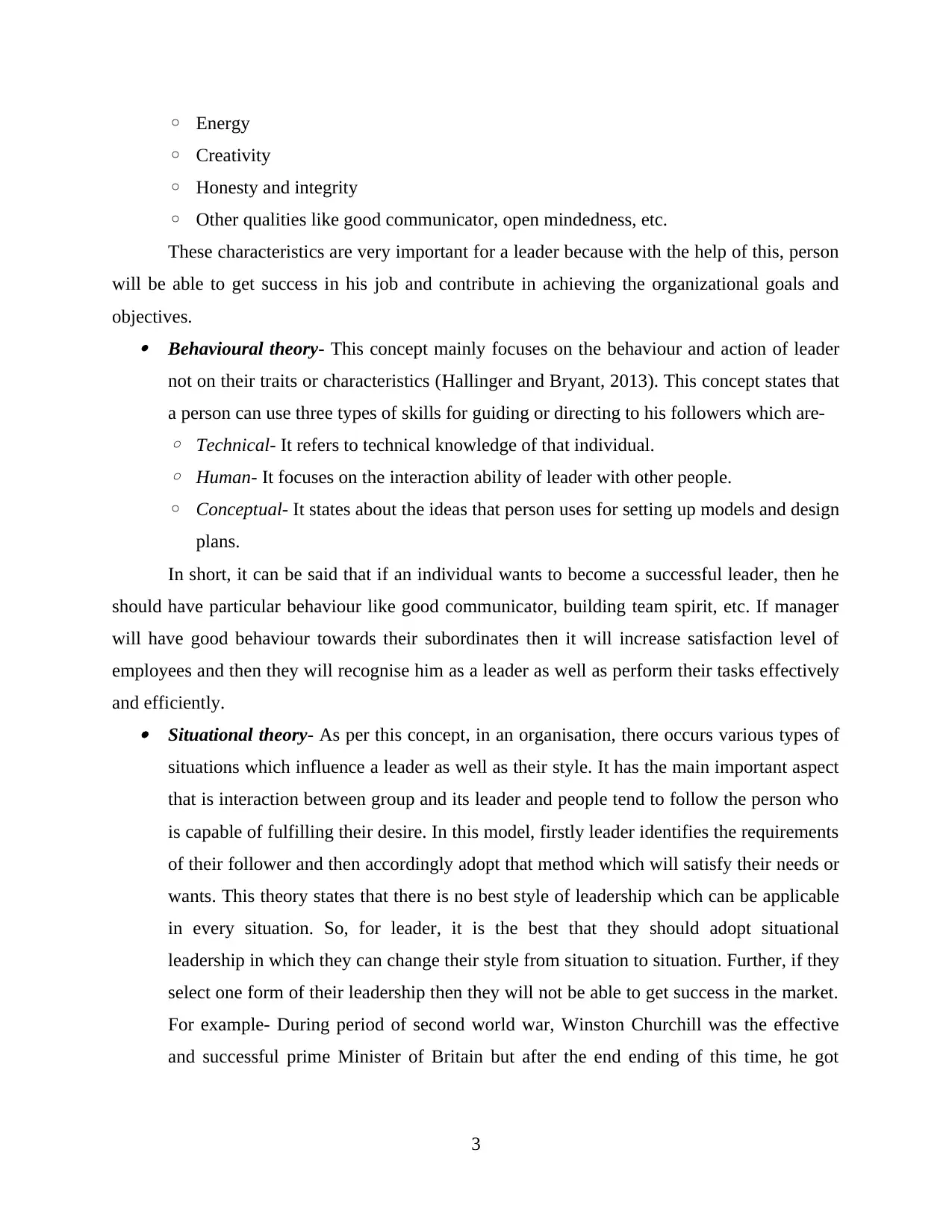
◦ Energy
◦ Creativity
◦ Honesty and integrity
◦ Other qualities like good communicator, open mindedness, etc.
These characteristics are very important for a leader because with the help of this, person
will be able to get success in his job and contribute in achieving the organizational goals and
objectives. Behavioural theory- This concept mainly focuses on the behaviour and action of leader
not on their traits or characteristics (Hallinger and Bryant, 2013). This concept states that
a person can use three types of skills for guiding or directing to his followers which are-
◦ Technical- It refers to technical knowledge of that individual.
◦ Human- It focuses on the interaction ability of leader with other people.
◦ Conceptual- It states about the ideas that person uses for setting up models and design
plans.
In short, it can be said that if an individual wants to become a successful leader, then he
should have particular behaviour like good communicator, building team spirit, etc. If manager
will have good behaviour towards their subordinates then it will increase satisfaction level of
employees and then they will recognise him as a leader as well as perform their tasks effectively
and efficiently. Situational theory- As per this concept, in an organisation, there occurs various types of
situations which influence a leader as well as their style. It has the main important aspect
that is interaction between group and its leader and people tend to follow the person who
is capable of fulfilling their desire. In this model, firstly leader identifies the requirements
of their follower and then accordingly adopt that method which will satisfy their needs or
wants. This theory states that there is no best style of leadership which can be applicable
in every situation. So, for leader, it is the best that they should adopt situational
leadership in which they can change their style from situation to situation. Further, if they
select one form of their leadership then they will not be able to get success in the market.
For example- During period of second world war, Winston Churchill was the effective
and successful prime Minister of Britain but after the end ending of this time, he got
3
◦ Creativity
◦ Honesty and integrity
◦ Other qualities like good communicator, open mindedness, etc.
These characteristics are very important for a leader because with the help of this, person
will be able to get success in his job and contribute in achieving the organizational goals and
objectives. Behavioural theory- This concept mainly focuses on the behaviour and action of leader
not on their traits or characteristics (Hallinger and Bryant, 2013). This concept states that
a person can use three types of skills for guiding or directing to his followers which are-
◦ Technical- It refers to technical knowledge of that individual.
◦ Human- It focuses on the interaction ability of leader with other people.
◦ Conceptual- It states about the ideas that person uses for setting up models and design
plans.
In short, it can be said that if an individual wants to become a successful leader, then he
should have particular behaviour like good communicator, building team spirit, etc. If manager
will have good behaviour towards their subordinates then it will increase satisfaction level of
employees and then they will recognise him as a leader as well as perform their tasks effectively
and efficiently. Situational theory- As per this concept, in an organisation, there occurs various types of
situations which influence a leader as well as their style. It has the main important aspect
that is interaction between group and its leader and people tend to follow the person who
is capable of fulfilling their desire. In this model, firstly leader identifies the requirements
of their follower and then accordingly adopt that method which will satisfy their needs or
wants. This theory states that there is no best style of leadership which can be applicable
in every situation. So, for leader, it is the best that they should adopt situational
leadership in which they can change their style from situation to situation. Further, if they
select one form of their leadership then they will not be able to get success in the market.
For example- During period of second world war, Winston Churchill was the effective
and successful prime Minister of Britain but after the end ending of this time, he got
3
⊘ This is a preview!⊘
Do you want full access?
Subscribe today to unlock all pages.

Trusted by 1+ million students worldwide
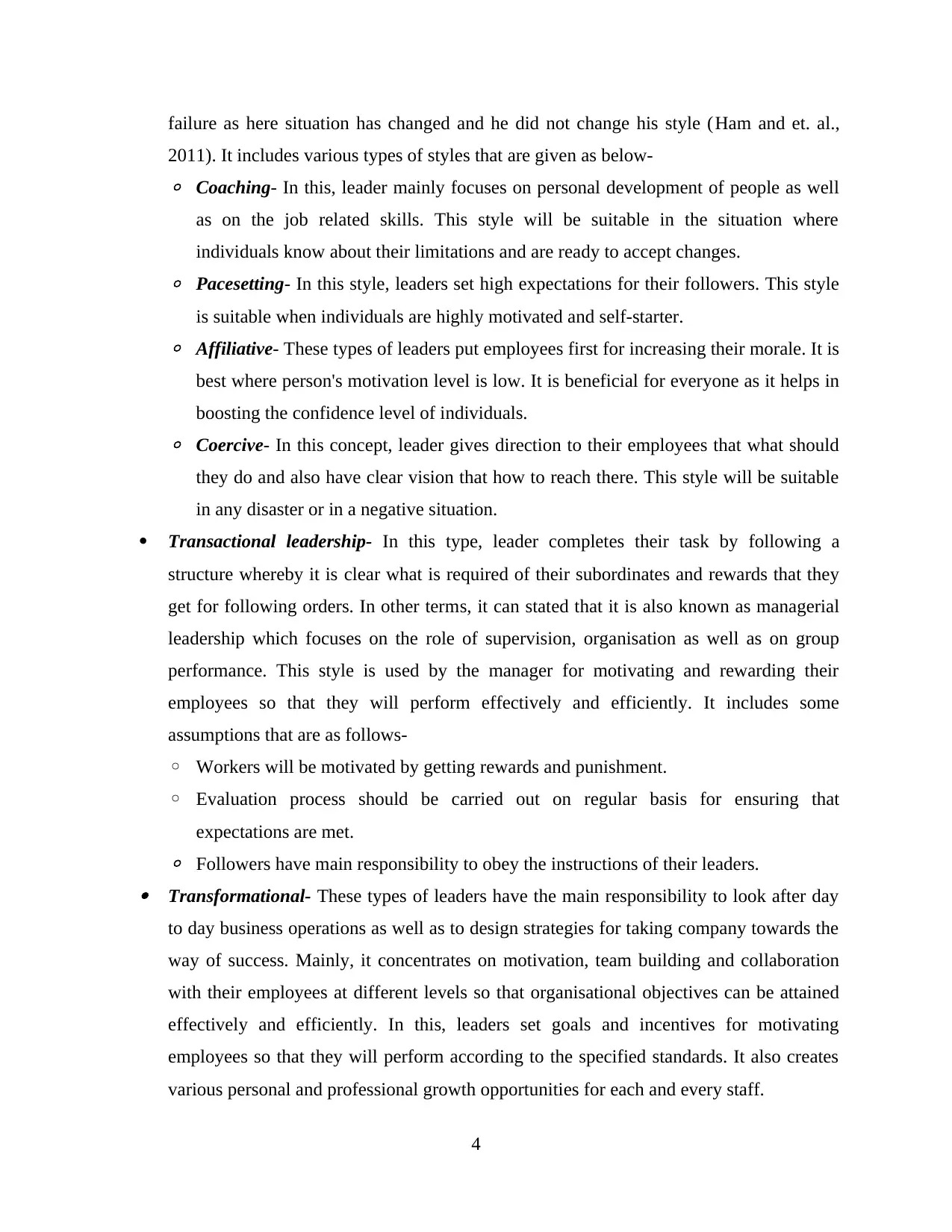
failure as here situation has changed and he did not change his style (Ham and et. al.,
2011). It includes various types of styles that are given as below-
◦ Coaching- In this, leader mainly focuses on personal development of people as well
as on the job related skills. This style will be suitable in the situation where
individuals know about their limitations and are ready to accept changes.
◦ Pacesetting- In this style, leaders set high expectations for their followers. This style
is suitable when individuals are highly motivated and self-starter.
◦ Affiliative- These types of leaders put employees first for increasing their morale. It is
best where person's motivation level is low. It is beneficial for everyone as it helps in
boosting the confidence level of individuals.
◦ Coercive- In this concept, leader gives direction to their employees that what should
they do and also have clear vision that how to reach there. This style will be suitable
in any disaster or in a negative situation.
Transactional leadership- In this type, leader completes their task by following a
structure whereby it is clear what is required of their subordinates and rewards that they
get for following orders. In other terms, it can stated that it is also known as managerial
leadership which focuses on the role of supervision, organisation as well as on group
performance. This style is used by the manager for motivating and rewarding their
employees so that they will perform effectively and efficiently. It includes some
assumptions that are as follows-
◦ Workers will be motivated by getting rewards and punishment.
◦ Evaluation process should be carried out on regular basis for ensuring that
expectations are met.
◦ Followers have main responsibility to obey the instructions of their leaders. Transformational- These types of leaders have the main responsibility to look after day
to day business operations as well as to design strategies for taking company towards the
way of success. Mainly, it concentrates on motivation, team building and collaboration
with their employees at different levels so that organisational objectives can be attained
effectively and efficiently. In this, leaders set goals and incentives for motivating
employees so that they will perform according to the specified standards. It also creates
various personal and professional growth opportunities for each and every staff.
4
2011). It includes various types of styles that are given as below-
◦ Coaching- In this, leader mainly focuses on personal development of people as well
as on the job related skills. This style will be suitable in the situation where
individuals know about their limitations and are ready to accept changes.
◦ Pacesetting- In this style, leaders set high expectations for their followers. This style
is suitable when individuals are highly motivated and self-starter.
◦ Affiliative- These types of leaders put employees first for increasing their morale. It is
best where person's motivation level is low. It is beneficial for everyone as it helps in
boosting the confidence level of individuals.
◦ Coercive- In this concept, leader gives direction to their employees that what should
they do and also have clear vision that how to reach there. This style will be suitable
in any disaster or in a negative situation.
Transactional leadership- In this type, leader completes their task by following a
structure whereby it is clear what is required of their subordinates and rewards that they
get for following orders. In other terms, it can stated that it is also known as managerial
leadership which focuses on the role of supervision, organisation as well as on group
performance. This style is used by the manager for motivating and rewarding their
employees so that they will perform effectively and efficiently. It includes some
assumptions that are as follows-
◦ Workers will be motivated by getting rewards and punishment.
◦ Evaluation process should be carried out on regular basis for ensuring that
expectations are met.
◦ Followers have main responsibility to obey the instructions of their leaders. Transformational- These types of leaders have the main responsibility to look after day
to day business operations as well as to design strategies for taking company towards the
way of success. Mainly, it concentrates on motivation, team building and collaboration
with their employees at different levels so that organisational objectives can be attained
effectively and efficiently. In this, leaders set goals and incentives for motivating
employees so that they will perform according to the specified standards. It also creates
various personal and professional growth opportunities for each and every staff.
4
Paraphrase This Document
Need a fresh take? Get an instant paraphrase of this document with our AI Paraphraser
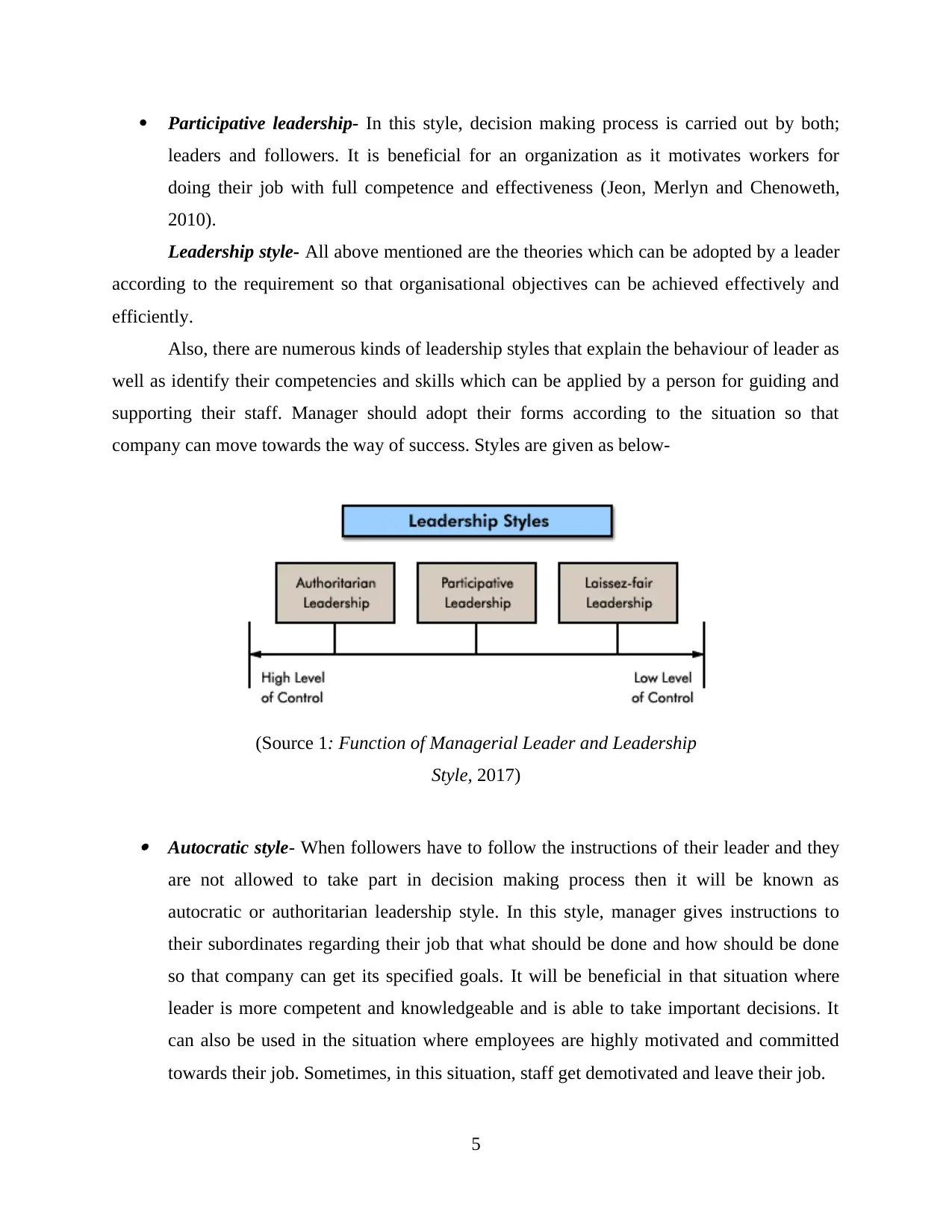
Participative leadership- In this style, decision making process is carried out by both;
leaders and followers. It is beneficial for an organization as it motivates workers for
doing their job with full competence and effectiveness (Jeon, Merlyn and Chenoweth,
2010).
Leadership style- All above mentioned are the theories which can be adopted by a leader
according to the requirement so that organisational objectives can be achieved effectively and
efficiently.
Also, there are numerous kinds of leadership styles that explain the behaviour of leader as
well as identify their competencies and skills which can be applied by a person for guiding and
supporting their staff. Manager should adopt their forms according to the situation so that
company can move towards the way of success. Styles are given as below-
Autocratic style- When followers have to follow the instructions of their leader and they
are not allowed to take part in decision making process then it will be known as
autocratic or authoritarian leadership style. In this style, manager gives instructions to
their subordinates regarding their job that what should be done and how should be done
so that company can get its specified goals. It will be beneficial in that situation where
leader is more competent and knowledgeable and is able to take important decisions. It
can also be used in the situation where employees are highly motivated and committed
towards their job. Sometimes, in this situation, staff get demotivated and leave their job.
5
(Source 1: Function of Managerial Leader and Leadership
Style, 2017)
leaders and followers. It is beneficial for an organization as it motivates workers for
doing their job with full competence and effectiveness (Jeon, Merlyn and Chenoweth,
2010).
Leadership style- All above mentioned are the theories which can be adopted by a leader
according to the requirement so that organisational objectives can be achieved effectively and
efficiently.
Also, there are numerous kinds of leadership styles that explain the behaviour of leader as
well as identify their competencies and skills which can be applied by a person for guiding and
supporting their staff. Manager should adopt their forms according to the situation so that
company can move towards the way of success. Styles are given as below-
Autocratic style- When followers have to follow the instructions of their leader and they
are not allowed to take part in decision making process then it will be known as
autocratic or authoritarian leadership style. In this style, manager gives instructions to
their subordinates regarding their job that what should be done and how should be done
so that company can get its specified goals. It will be beneficial in that situation where
leader is more competent and knowledgeable and is able to take important decisions. It
can also be used in the situation where employees are highly motivated and committed
towards their job. Sometimes, in this situation, staff get demotivated and leave their job.
5
(Source 1: Function of Managerial Leader and Leadership
Style, 2017)
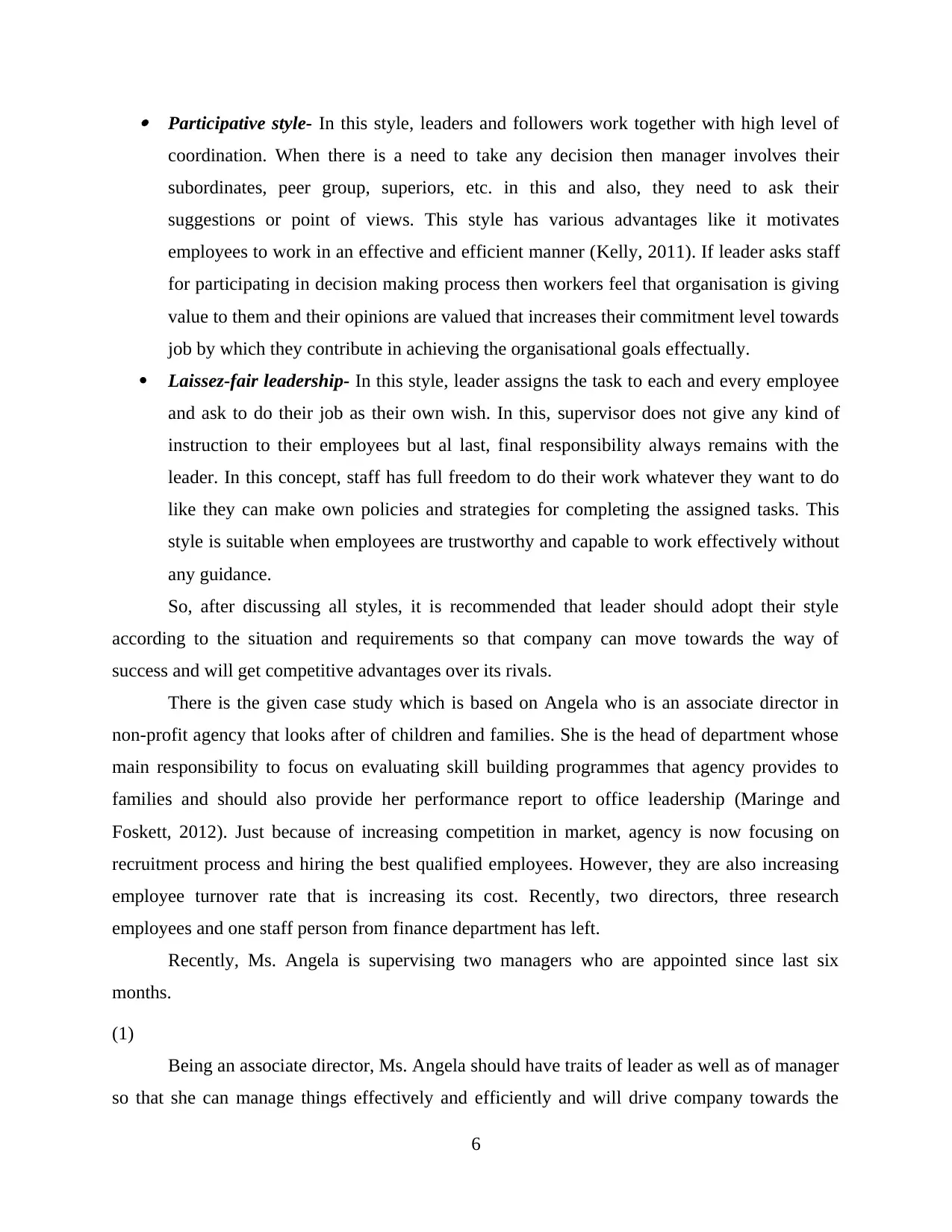
Participative style- In this style, leaders and followers work together with high level of
coordination. When there is a need to take any decision then manager involves their
subordinates, peer group, superiors, etc. in this and also, they need to ask their
suggestions or point of views. This style has various advantages like it motivates
employees to work in an effective and efficient manner (Kelly, 2011). If leader asks staff
for participating in decision making process then workers feel that organisation is giving
value to them and their opinions are valued that increases their commitment level towards
job by which they contribute in achieving the organisational goals effectually.
Laissez-fair leadership- In this style, leader assigns the task to each and every employee
and ask to do their job as their own wish. In this, supervisor does not give any kind of
instruction to their employees but al last, final responsibility always remains with the
leader. In this concept, staff has full freedom to do their work whatever they want to do
like they can make own policies and strategies for completing the assigned tasks. This
style is suitable when employees are trustworthy and capable to work effectively without
any guidance.
So, after discussing all styles, it is recommended that leader should adopt their style
according to the situation and requirements so that company can move towards the way of
success and will get competitive advantages over its rivals.
There is the given case study which is based on Angela who is an associate director in
non-profit agency that looks after of children and families. She is the head of department whose
main responsibility to focus on evaluating skill building programmes that agency provides to
families and should also provide her performance report to office leadership (Maringe and
Foskett, 2012). Just because of increasing competition in market, agency is now focusing on
recruitment process and hiring the best qualified employees. However, they are also increasing
employee turnover rate that is increasing its cost. Recently, two directors, three research
employees and one staff person from finance department has left.
Recently, Ms. Angela is supervising two managers who are appointed since last six
months.
(1)
Being an associate director, Ms. Angela should have traits of leader as well as of manager
so that she can manage things effectively and efficiently and will drive company towards the
6
coordination. When there is a need to take any decision then manager involves their
subordinates, peer group, superiors, etc. in this and also, they need to ask their
suggestions or point of views. This style has various advantages like it motivates
employees to work in an effective and efficient manner (Kelly, 2011). If leader asks staff
for participating in decision making process then workers feel that organisation is giving
value to them and their opinions are valued that increases their commitment level towards
job by which they contribute in achieving the organisational goals effectually.
Laissez-fair leadership- In this style, leader assigns the task to each and every employee
and ask to do their job as their own wish. In this, supervisor does not give any kind of
instruction to their employees but al last, final responsibility always remains with the
leader. In this concept, staff has full freedom to do their work whatever they want to do
like they can make own policies and strategies for completing the assigned tasks. This
style is suitable when employees are trustworthy and capable to work effectively without
any guidance.
So, after discussing all styles, it is recommended that leader should adopt their style
according to the situation and requirements so that company can move towards the way of
success and will get competitive advantages over its rivals.
There is the given case study which is based on Angela who is an associate director in
non-profit agency that looks after of children and families. She is the head of department whose
main responsibility to focus on evaluating skill building programmes that agency provides to
families and should also provide her performance report to office leadership (Maringe and
Foskett, 2012). Just because of increasing competition in market, agency is now focusing on
recruitment process and hiring the best qualified employees. However, they are also increasing
employee turnover rate that is increasing its cost. Recently, two directors, three research
employees and one staff person from finance department has left.
Recently, Ms. Angela is supervising two managers who are appointed since last six
months.
(1)
Being an associate director, Ms. Angela should have traits of leader as well as of manager
so that she can manage things effectively and efficiently and will drive company towards the
6
⊘ This is a preview!⊘
Do you want full access?
Subscribe today to unlock all pages.

Trusted by 1+ million students worldwide
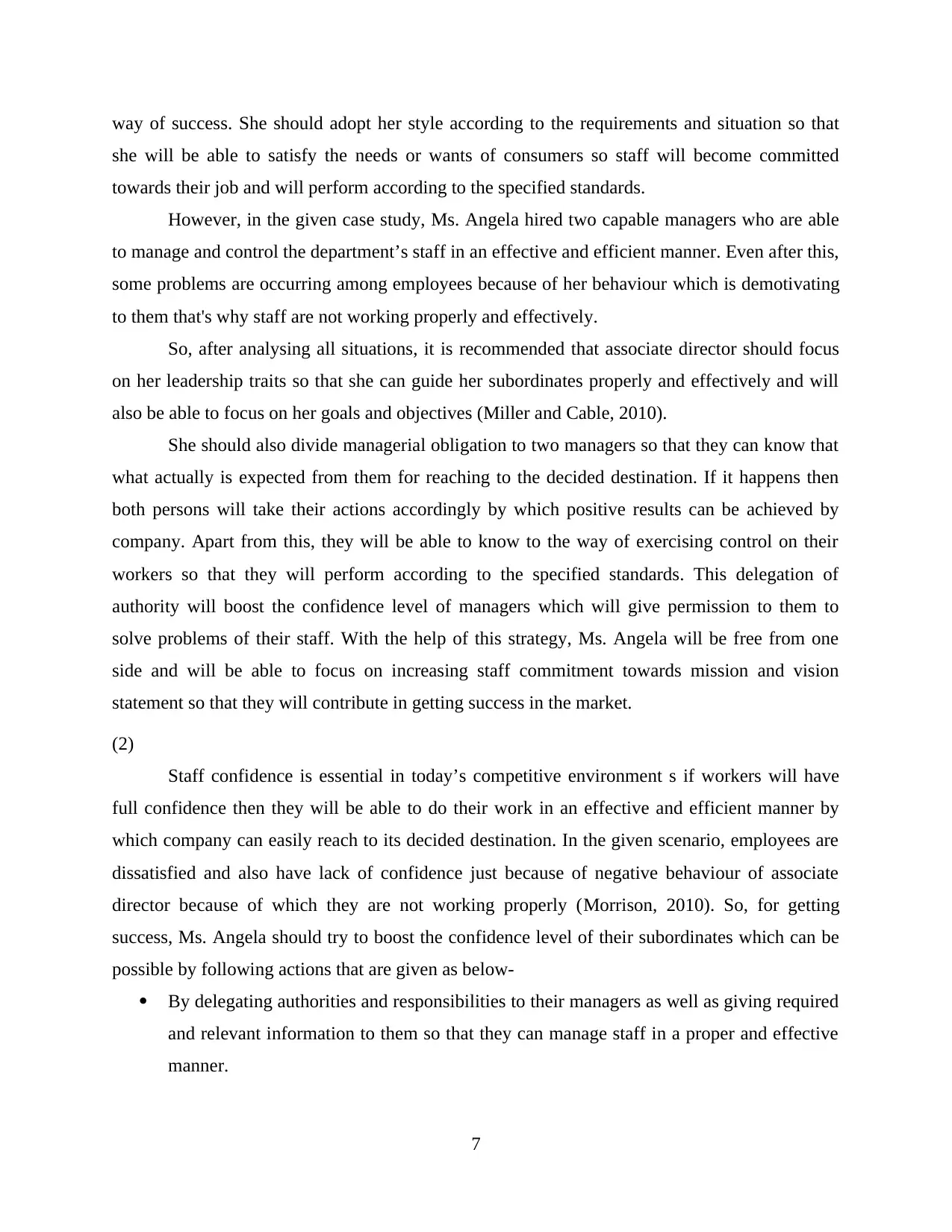
way of success. She should adopt her style according to the requirements and situation so that
she will be able to satisfy the needs or wants of consumers so staff will become committed
towards their job and will perform according to the specified standards.
However, in the given case study, Ms. Angela hired two capable managers who are able
to manage and control the department’s staff in an effective and efficient manner. Even after this,
some problems are occurring among employees because of her behaviour which is demotivating
to them that's why staff are not working properly and effectively.
So, after analysing all situations, it is recommended that associate director should focus
on her leadership traits so that she can guide her subordinates properly and effectively and will
also be able to focus on her goals and objectives (Miller and Cable, 2010).
She should also divide managerial obligation to two managers so that they can know that
what actually is expected from them for reaching to the decided destination. If it happens then
both persons will take their actions accordingly by which positive results can be achieved by
company. Apart from this, they will be able to know to the way of exercising control on their
workers so that they will perform according to the specified standards. This delegation of
authority will boost the confidence level of managers which will give permission to them to
solve problems of their staff. With the help of this strategy, Ms. Angela will be free from one
side and will be able to focus on increasing staff commitment towards mission and vision
statement so that they will contribute in getting success in the market.
(2)
Staff confidence is essential in today’s competitive environment s if workers will have
full confidence then they will be able to do their work in an effective and efficient manner by
which company can easily reach to its decided destination. In the given scenario, employees are
dissatisfied and also have lack of confidence just because of negative behaviour of associate
director because of which they are not working properly (Morrison, 2010). So, for getting
success, Ms. Angela should try to boost the confidence level of their subordinates which can be
possible by following actions that are given as below-
By delegating authorities and responsibilities to their managers as well as giving required
and relevant information to them so that they can manage staff in a proper and effective
manner.
7
she will be able to satisfy the needs or wants of consumers so staff will become committed
towards their job and will perform according to the specified standards.
However, in the given case study, Ms. Angela hired two capable managers who are able
to manage and control the department’s staff in an effective and efficient manner. Even after this,
some problems are occurring among employees because of her behaviour which is demotivating
to them that's why staff are not working properly and effectively.
So, after analysing all situations, it is recommended that associate director should focus
on her leadership traits so that she can guide her subordinates properly and effectively and will
also be able to focus on her goals and objectives (Miller and Cable, 2010).
She should also divide managerial obligation to two managers so that they can know that
what actually is expected from them for reaching to the decided destination. If it happens then
both persons will take their actions accordingly by which positive results can be achieved by
company. Apart from this, they will be able to know to the way of exercising control on their
workers so that they will perform according to the specified standards. This delegation of
authority will boost the confidence level of managers which will give permission to them to
solve problems of their staff. With the help of this strategy, Ms. Angela will be free from one
side and will be able to focus on increasing staff commitment towards mission and vision
statement so that they will contribute in getting success in the market.
(2)
Staff confidence is essential in today’s competitive environment s if workers will have
full confidence then they will be able to do their work in an effective and efficient manner by
which company can easily reach to its decided destination. In the given scenario, employees are
dissatisfied and also have lack of confidence just because of negative behaviour of associate
director because of which they are not working properly (Morrison, 2010). So, for getting
success, Ms. Angela should try to boost the confidence level of their subordinates which can be
possible by following actions that are given as below-
By delegating authorities and responsibilities to their managers as well as giving required
and relevant information to them so that they can manage staff in a proper and effective
manner.
7
Paraphrase This Document
Need a fresh take? Get an instant paraphrase of this document with our AI Paraphraser
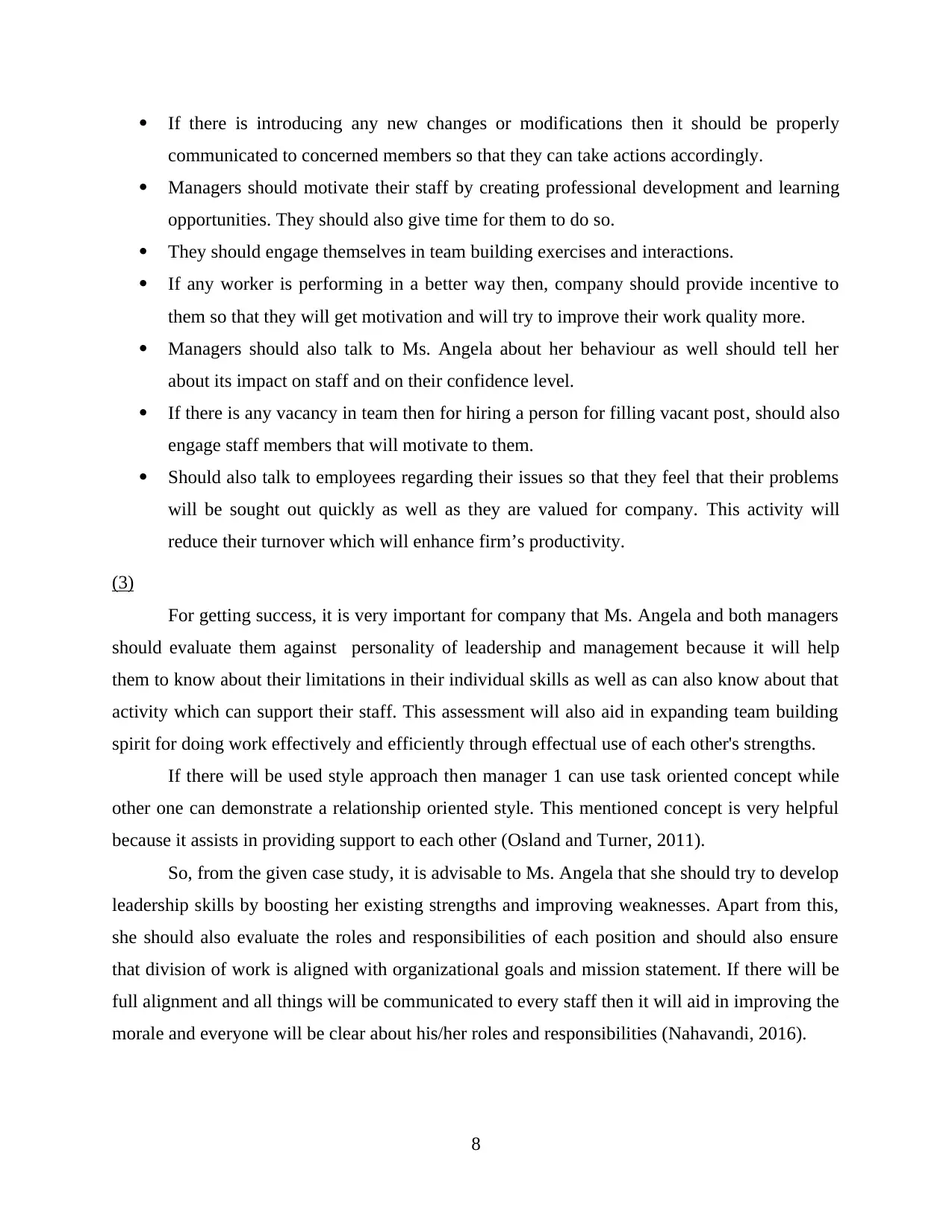
If there is introducing any new changes or modifications then it should be properly
communicated to concerned members so that they can take actions accordingly.
Managers should motivate their staff by creating professional development and learning
opportunities. They should also give time for them to do so.
They should engage themselves in team building exercises and interactions.
If any worker is performing in a better way then, company should provide incentive to
them so that they will get motivation and will try to improve their work quality more.
Managers should also talk to Ms. Angela about her behaviour as well should tell her
about its impact on staff and on their confidence level.
If there is any vacancy in team then for hiring a person for filling vacant post, should also
engage staff members that will motivate to them.
Should also talk to employees regarding their issues so that they feel that their problems
will be sought out quickly as well as they are valued for company. This activity will
reduce their turnover which will enhance firm’s productivity.
(3)
For getting success, it is very important for company that Ms. Angela and both managers
should evaluate them against personality of leadership and management because it will help
them to know about their limitations in their individual skills as well as can also know about that
activity which can support their staff. This assessment will also aid in expanding team building
spirit for doing work effectively and efficiently through effectual use of each other's strengths.
If there will be used style approach then manager 1 can use task oriented concept while
other one can demonstrate a relationship oriented style. This mentioned concept is very helpful
because it assists in providing support to each other (Osland and Turner, 2011).
So, from the given case study, it is advisable to Ms. Angela that she should try to develop
leadership skills by boosting her existing strengths and improving weaknesses. Apart from this,
she should also evaluate the roles and responsibilities of each position and should also ensure
that division of work is aligned with organizational goals and mission statement. If there will be
full alignment and all things will be communicated to every staff then it will aid in improving the
morale and everyone will be clear about his/her roles and responsibilities (Nahavandi, 2016).
8
communicated to concerned members so that they can take actions accordingly.
Managers should motivate their staff by creating professional development and learning
opportunities. They should also give time for them to do so.
They should engage themselves in team building exercises and interactions.
If any worker is performing in a better way then, company should provide incentive to
them so that they will get motivation and will try to improve their work quality more.
Managers should also talk to Ms. Angela about her behaviour as well should tell her
about its impact on staff and on their confidence level.
If there is any vacancy in team then for hiring a person for filling vacant post, should also
engage staff members that will motivate to them.
Should also talk to employees regarding their issues so that they feel that their problems
will be sought out quickly as well as they are valued for company. This activity will
reduce their turnover which will enhance firm’s productivity.
(3)
For getting success, it is very important for company that Ms. Angela and both managers
should evaluate them against personality of leadership and management because it will help
them to know about their limitations in their individual skills as well as can also know about that
activity which can support their staff. This assessment will also aid in expanding team building
spirit for doing work effectively and efficiently through effectual use of each other's strengths.
If there will be used style approach then manager 1 can use task oriented concept while
other one can demonstrate a relationship oriented style. This mentioned concept is very helpful
because it assists in providing support to each other (Osland and Turner, 2011).
So, from the given case study, it is advisable to Ms. Angela that she should try to develop
leadership skills by boosting her existing strengths and improving weaknesses. Apart from this,
she should also evaluate the roles and responsibilities of each position and should also ensure
that division of work is aligned with organizational goals and mission statement. If there will be
full alignment and all things will be communicated to every staff then it will aid in improving the
morale and everyone will be clear about his/her roles and responsibilities (Nahavandi, 2016).
8
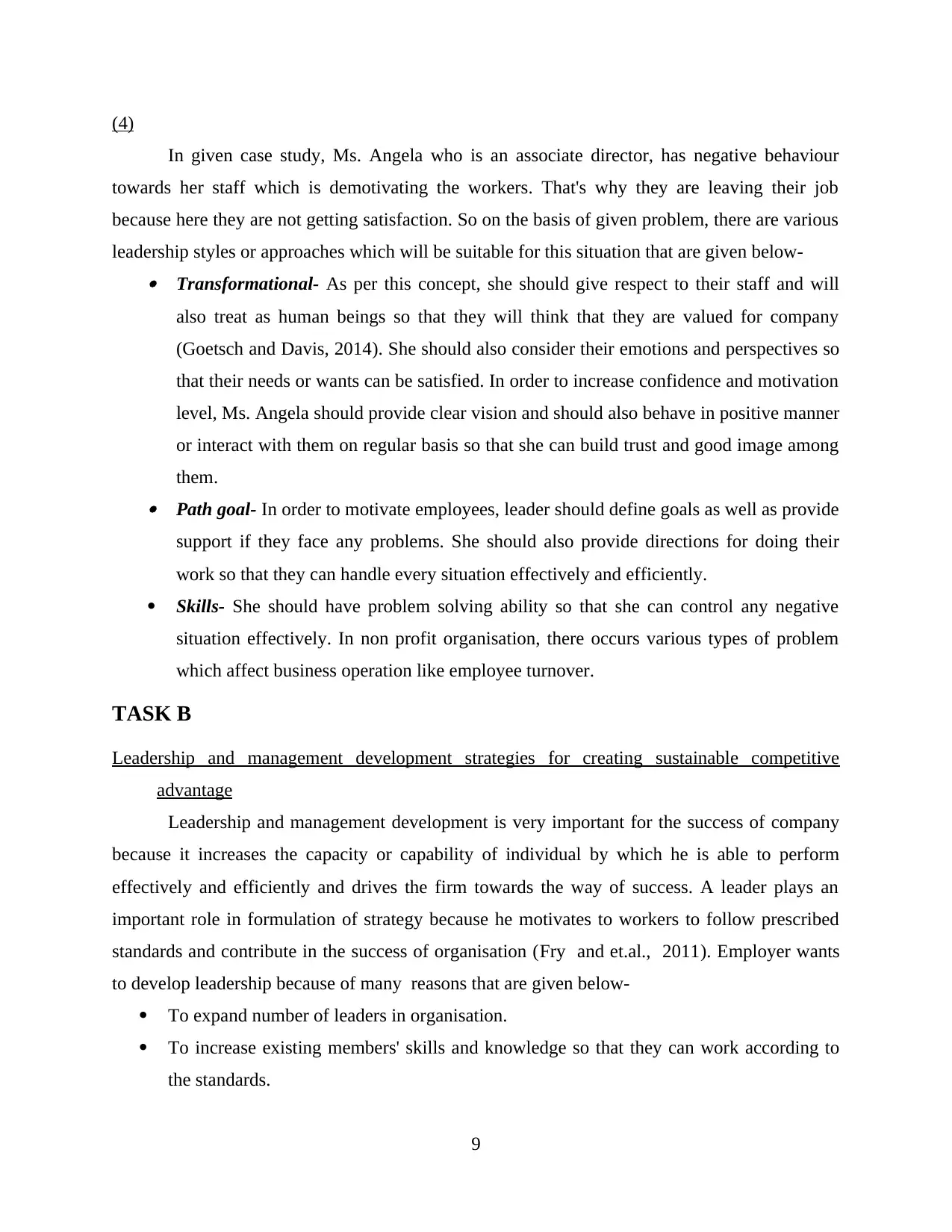
(4)
In given case study, Ms. Angela who is an associate director, has negative behaviour
towards her staff which is demotivating the workers. That's why they are leaving their job
because here they are not getting satisfaction. So on the basis of given problem, there are various
leadership styles or approaches which will be suitable for this situation that are given below- Transformational- As per this concept, she should give respect to their staff and will
also treat as human beings so that they will think that they are valued for company
(Goetsch and Davis, 2014). She should also consider their emotions and perspectives so
that their needs or wants can be satisfied. In order to increase confidence and motivation
level, Ms. Angela should provide clear vision and should also behave in positive manner
or interact with them on regular basis so that she can build trust and good image among
them. Path goal- In order to motivate employees, leader should define goals as well as provide
support if they face any problems. She should also provide directions for doing their
work so that they can handle every situation effectively and efficiently.
Skills- She should have problem solving ability so that she can control any negative
situation effectively. In non profit organisation, there occurs various types of problem
which affect business operation like employee turnover.
TASK B
Leadership and management development strategies for creating sustainable competitive
advantage
Leadership and management development is very important for the success of company
because it increases the capacity or capability of individual by which he is able to perform
effectively and efficiently and drives the firm towards the way of success. A leader plays an
important role in formulation of strategy because he motivates to workers to follow prescribed
standards and contribute in the success of organisation (Fry and et.al., 2011). Employer wants
to develop leadership because of many reasons that are given below-
To expand number of leaders in organisation.
To increase existing members' skills and knowledge so that they can work according to
the standards.
9
In given case study, Ms. Angela who is an associate director, has negative behaviour
towards her staff which is demotivating the workers. That's why they are leaving their job
because here they are not getting satisfaction. So on the basis of given problem, there are various
leadership styles or approaches which will be suitable for this situation that are given below- Transformational- As per this concept, she should give respect to their staff and will
also treat as human beings so that they will think that they are valued for company
(Goetsch and Davis, 2014). She should also consider their emotions and perspectives so
that their needs or wants can be satisfied. In order to increase confidence and motivation
level, Ms. Angela should provide clear vision and should also behave in positive manner
or interact with them on regular basis so that she can build trust and good image among
them. Path goal- In order to motivate employees, leader should define goals as well as provide
support if they face any problems. She should also provide directions for doing their
work so that they can handle every situation effectively and efficiently.
Skills- She should have problem solving ability so that she can control any negative
situation effectively. In non profit organisation, there occurs various types of problem
which affect business operation like employee turnover.
TASK B
Leadership and management development strategies for creating sustainable competitive
advantage
Leadership and management development is very important for the success of company
because it increases the capacity or capability of individual by which he is able to perform
effectively and efficiently and drives the firm towards the way of success. A leader plays an
important role in formulation of strategy because he motivates to workers to follow prescribed
standards and contribute in the success of organisation (Fry and et.al., 2011). Employer wants
to develop leadership because of many reasons that are given below-
To expand number of leaders in organisation.
To increase existing members' skills and knowledge so that they can work according to
the standards.
9
⊘ This is a preview!⊘
Do you want full access?
Subscribe today to unlock all pages.

Trusted by 1+ million students worldwide
1 out of 18
Related Documents
Your All-in-One AI-Powered Toolkit for Academic Success.
+13062052269
info@desklib.com
Available 24*7 on WhatsApp / Email
![[object Object]](/_next/static/media/star-bottom.7253800d.svg)
Unlock your academic potential
Copyright © 2020–2025 A2Z Services. All Rights Reserved. Developed and managed by ZUCOL.




